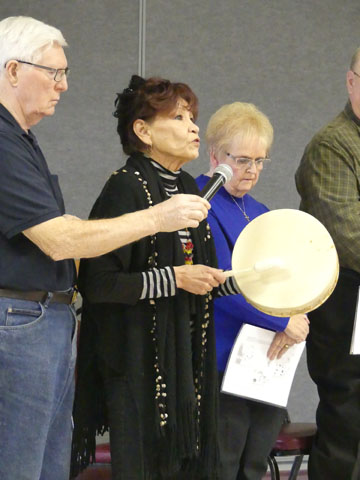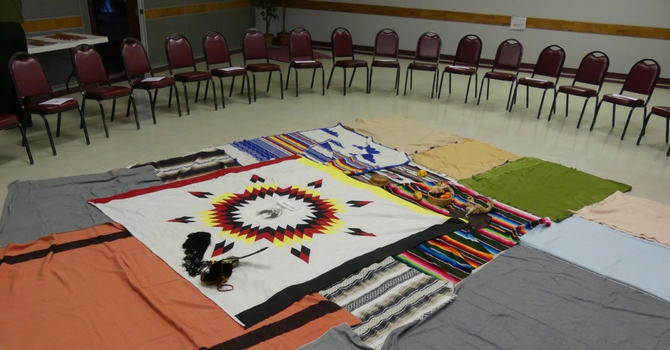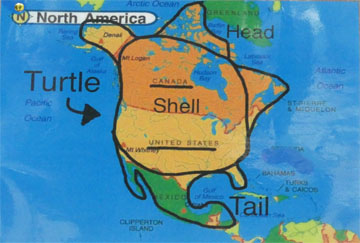
On Saturday, October 28, Oak Bank United Church, in the spirit of reconciliation, with First Nations brothers and sisters, hosted what is appropriately entitled a Blanket Exercise. With every audience the ceremony teaches—in a most emotional and visually tactile way—the history of pre-colonization, then colonization, then proceeding to what, since 1996 unto our present, its impact on Indigenous peoples, indeed on this land and all of its people which we know as Canada.
This event was developed and provided by Kairos, “a faith-based social justice organization which works with ten churches and religious organizations in faithful action for ecological justice and human rights.” It is a charitable joint venture administered by the United Church of Canada. The teaching session, hosted by the Oak Bank United Church, was conducted by Sandy Siha, an Indigenous elder and keeper of knowledge of her people in the context of Aboriginal beliefs and an embracing of the Christian Church.
 The session began with a “smudging,” a cleansing of the attendees which symbolically signifies our readiness to interact as Indigenous peoples affected by the aforesaid colonization and its governments over a period of 500 years to the present. A second part of the commencement dealt with a prayer, an invocation by way of a “soft” drumming to simulate the heartbeat of Mother Earth that bears solemn witness to the ways of Indigenous peoples and the blanket ceremony itself. The ceremony literally makes use of blankets to represent the lands of the Indigenous peoples of pre- and post-colonization, a land in ancient times which was, and still is, in lore and ceremony called Turtle Island, and which geographically embraced all of North America, therefore the Indigenous peoples who populated what is now known as United States and Mexico. Using the topographical map of Canada to its present-day 49th parallel border, a participant sees that the distribution of, and occupation by, Indigenous peoples once extended, literally, from sea to sea and from Canada’s northern ocean to what is now Central America.
The session began with a “smudging,” a cleansing of the attendees which symbolically signifies our readiness to interact as Indigenous peoples affected by the aforesaid colonization and its governments over a period of 500 years to the present. A second part of the commencement dealt with a prayer, an invocation by way of a “soft” drumming to simulate the heartbeat of Mother Earth that bears solemn witness to the ways of Indigenous peoples and the blanket ceremony itself. The ceremony literally makes use of blankets to represent the lands of the Indigenous peoples of pre- and post-colonization, a land in ancient times which was, and still is, in lore and ceremony called Turtle Island, and which geographically embraced all of North America, therefore the Indigenous peoples who populated what is now known as United States and Mexico. Using the topographical map of Canada to its present-day 49th parallel border, a participant sees that the distribution of, and occupation by, Indigenous peoples once extended, literally, from sea to sea and from Canada’s northern ocean to what is now Central America.
The Blanket Exercise
The blankets spread side by side on the floor represent the land that was occupied prior to European  exploration and as colonization, with aggressive determination[1], encroached on it. That is to say, Aboriginal Peoples occupied almost all of Turtle Island, in thousands of distinct societies, a distribution of eleven linguistic tribes alone at the time of contact with Europeans in what came to be Canada:
exploration and as colonization, with aggressive determination[1], encroached on it. That is to say, Aboriginal Peoples occupied almost all of Turtle Island, in thousands of distinct societies, a distribution of eleven linguistic tribes alone at the time of contact with Europeans in what came to be Canada:
Land reserved for Aboriginal Peoples was soon and steadily diminished in size in relation to the original guarantees of the reserve grants. Almost two-thirds of it have disappeared by various means since Confederation. In some cases, governments failed to deliver as much land for which the treaties were signed in good faith on the part of the Aboriginal Peoples. In other cases it was expropriated outright; in a few cases land was unilaterally “exchanged for other, often inferior [and unsustaining] land.” In many situations, Native leaders were “tricked” into selling parts of their land granted to them. Almost all transactions had the taint of fraud. In more recent times the resources on or under their land grants were not considered part of the reserves’ treaty agreements, and were sold to “outside interests.”[2]

As our narrator identified examples of the “dishonouring” of many of the treaties, by consecutive governments and exploitation by other agencies, the participants had to move off the blanket serving as their new land and their “modified” heritage. These “codicils,” the diminution of the allocated reserve land has occurred to both the times of pre-Confederation treaties and to Treaties 1 to 10, applying to lands of provinces as they entered into the Confederation of Canada from 1871 to 1923, have invariably caused the reserves great difficulties in trying to sustain themselves on their shrinking resources.
Discussion Following the Blanket Exercise
There were 70+ participants in attendance besides the Elder and the Kairos representatives and assistants. We were invited to comment on what we had witnessed by way of the exercise and how it may have helped in strengthening our understanding of the First Nations people, in pre-Colonization, European Colonization, and since Confederation. Almost all provided most apt insights into the blanket exercise and subsequent discussion. It would not be wrong to employ single words to our common conclusion of the Indigenous experience: “systematic victimization and betrayal.” Here are a few:
- Genocide – the Beothuk People of present-day Newfoundland were the first to come in contact with European voyagers, and they were exterminated systematically by bounty hunting and denial of access to their traditional hunting lands. Another form of genocide was the deliberate, widespread contamination of a fatal disease, small pox, on blankets traded to the Indigenous peoples. This was another reason why lands could be re-taken from the Indigenous peoples.
- Inequities of the Indian Act – large numbers of excluded Indigenous women do not have the
treaty rights of Indigenous men, a contravention of the Charter of Rights and Freedoms. This inequity and alienation is seen as a factor in the large numbers of missing and murdered Aboriginal women and girls, but needful revision to the Act sits, unattended by government. - While the Federal government has responsibility for Native education, grants to the reserves are set at three-quarters of provincial grand amounts directed to each student in the public school systems.
- Water free of contamination on countless reserves makes living conditions akin to horrors of third-world countries. The Shoal Lake Band of Ontario has had a boil water advisory for 17 years! Access to a mainland highway has yet to be addressed fully.
- Teen suicides on reserves are of epidemic proportions; and while there are multi-causative factors associated with them, professional personnel are urgently needed on an increased visit frequency, and the reserve communities must be inserviced to build a strong, collective will in order to make lives free of sub-cultural drugs with alternate Indigenous cultural diversions such as sports, dancing, and music being a regular immersion in the schools and community halls. The vista of learning by satellite must be strengthened to combat isolation and to witness opportunities hitherto denied the children.
In conclusion, Royal Commissions looking into Indigenous rights, recognized plights, and fostering self-determination have thus far failed. The Blanket Exercise has a will of its own. May many, many thousands more benefit from it! What better way to learn truly of the Indigenous people but by them!
Respectfully submitted, Don Carruthers
____________________
[1] European colonizers to America referred to their seizure of Native lands and their wars with them as “Manifest Destiny,” the will of God.
[2] Source: National Atlas Information Services map MCR4162 @ 1991 and Looking Forward, Looking Back, Report of the Royal Commission on Aboriginal with permission from Minister of Public Works and Government Services of Canada and the Privy Council Office, 1977.